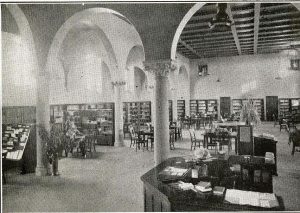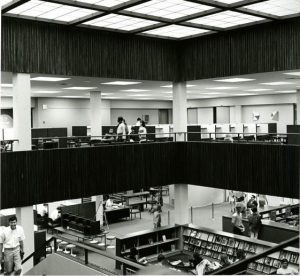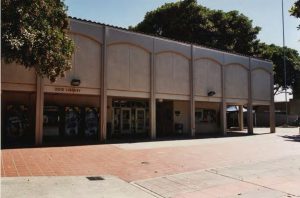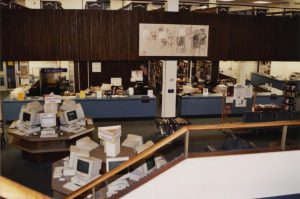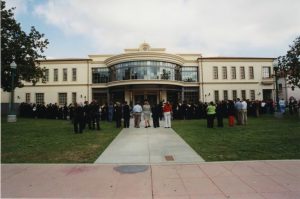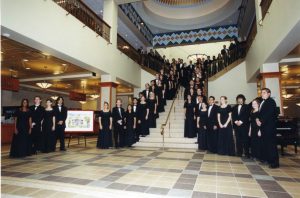Fullerton College Library
Library & FC History
The Fullerton College Library serves thousands of students each year through its online resources and print materials. Faculty librarians teach one unit Library 100 courses and single sessions for classes that include English, Counseling, ESL, and more. The library has continually evolved over the years to meet the challenges of changing technology. Librarians have incorporated social networking tools to keep students updated on the latest library news. While librarians use databases, eBooks, online tutorials, Facebook, Twitter, blogs, and chatboxes to reach the students whether they are on or off-campus, the library prides itself on its personal service.
The library also keeps a collection of archived materials about Fullerton College, a pictorial history of Fullerton College, two collections of rare dolls, a digital collection of college catalogs, and a hall of fame of Fullerton College alumni.
1913-1950
The William T. Boyce Library has been around! It’s traveled! There’s nothing static about this library! It’s moved five times in the last seventy-five years and continually kept up with technology! The library began soon after the college began in 1913, when it took over a small section in the Fullerton High School Library. That was a beautiful library of Spanish design which had been modeled after a famous library in Salamanca, Spain. It had pillars and arches and wrought iron chandeliers which had been forged in the high school metal shop. It was quite luxurious.
Then some years later in 1929 when the junior college had grown and there was even a Junior College Building on the high school campus the library made its first move, to a space of its own, though it wasn’t so luxurious. It was a barn-like room in what had been the high schools girls’ gymnasium. One of the two librarians of that year described it as a “high, huge, great big old building.” When she came to work in the morning she’d find “bats hanging from the ceiling,” which the custodian would have to catch in a net and remove before school started!
The Thirties was the era of the Great Depression, but even so the Fullerton Union High School and Junior College District was able to buy property just east of the high school which had been orange and walnut groves. Assisted by the Works Progress Administration, the district built three college buildings on this property which was the nucleus of the new college campus, the library was given space on the second floor of the “Science Building.” Today, it’s known as the North Science or 600 Building. So in 1938 the library moved for the second time.
This facility with its long study tables and blond furnishings was adequate during the World War II years when Fullerton College became virtually a small college for women. After the War, however, there was a population boom in Orange County and the student body numbers increased, and very soon all of the college facilities including the library, where the books and magazines were stacked on tables and chairs, were very cramped.
1950-1988 (75th Anniversary)
Beginning in the 1950’s and continuing through the 1960’s, the college district carried out a long-range construction project to meet the needs of the increased enrollment. This time the plans included a building which would house the library on the first floor, while rooms for social science and English classes would take up the second floor. It was completed in 1957 and the library made its third move, into these new quarters which had been designed as much as possible “like college reading rooms at UCLA or USC.” When the building was dedicated in October of that year Jessamyn West, the well-know author, who grew up in Orange County, was the guest speaker.
During all these years the library was known only as “the library”. It wasn’t until 1962 when it was given the more formal title of the “William T. Boyce Library” when the college honored the man who had come to the college in 1915 and was its dean and president from 1918 until his retirement in 1951.
The period of the Fifties and the Sixties was the era of the campus “Dress Code,”, no slacks or shorts could be worn by the women students, no shorts or cut-offs for the men students, and absolutely no one was allowed to go barefoot on campus. “Audiovisual” was becoming a popular library term, by which meant the records and players for music and foreign language listening; there was even modern automated circulation systems.
From Spanish décor, to bats on the ceiling, to overflowing bookshelves, to temporary quarters, to computer driven catalog and circulation systems, it’s been a good 75 years! There’s been nothing static about this library.
1989 – 2004
by Deb Richey and Jane Ishbashi (2012)
On April 22, 1985, the William T. Boyce Library moved into the computerized age by unveiling its new online catalog, FullCat, which replaced the old catalog card system. To familiarize the campus community with the new library catalog, librarians produced written guides and conducted a series of orientation sessions. During its first semester of use, 266,438 searches were conducted on FullCat by students, faculty, and staff. The library went through a series of major changes in online research capabilities during the 1980s and 1990s. Librarians first offered mediated computer searching through databases on a service called DIALOG, then switched to using a CD-ROM system, InfoTrac, to find articles. InfoTrac, which allowed students to conduct their own searches, was so popular that the library asked the Associated Students to partially fund the computer system, but the request was denied. The CD-ROM system was replaced in the 2000s by online databases that were available on campus and remotely to students, faculty, and staff.
The first campus connection to the Internet was made in 1995. Thirty computers were connected, three in the library, and the rest in the T-7 lab. To introduce students to the new technology, the first course on the Internet was offered, Introduction to the Internet, which covered the World Wide Web, Netiquette, and e-mail services.
In the fall of 1999, the Fullerton College Library was shut down for the removal of asbestos and some minor renovations. The library operated in temporary quarters—an 8,000-square-foot tent—set up in the quad. The “Big Top” Library offered twenty computer terminals and a selection of reference books, along with limited number of journals and circulating materials. Few books were available and students were directed to California State University, Fullerton and the Fullerton Public Library for further assistance.
After the refurbishment, the library was rededicated on Tuesday, April 25, 2000. Following seven months of construction, the renovated facility featured new classrooms, nearly 100 more computer workstations, new lighting, new carpeting, and new ceilings. Funds for the renovation project were provided by state and federal monies, in addition to contributions from the Friends of the Fullerton College Library, a non-profit fundraising arm of the library.
2005 – 2012
by Deb Richey and Jane Ishbashi (2012)
The new Fullerton College Library and Learning Resources Center (LLRC) dedication was held October 28, 2005. The new 67,680-square-foot building housed the William T. Boyce Library, the Academic Support Center (the Skills Center, Reading Lab, Tutoring Center, Writing Center); the Adaptive Computer Lab; and the Math and Computer Science Lab. The library portion of the building was spread over two floors with a dramatic central stairway, a 73-foot-high dome, ornate wrought iron banisters, decorative tile, and period-style lighting. To blend in harmoniously with the campus, the architecture reflects the Spanish Colonial Revival style of the Public Works Administration (PWA) and the Works Project Administration (WPA) structures added to the campus in the 1930s. The new library was featured in the April 2006 issue of American Libraries.
Despite the impressive building, the new library was not without its problems. In the academic year 2007-2008, staff and students were startled by a mysterious crash that went unexplained for several days until another loud crash resounded through the library. Staff then discovered that the library dome tiles were sliding off in sections and falling on the roof. After a lengthy delay, the new dome was installed on April 25, 2009.
WiFi access was available in the Quad south of the Library and Learning Resources Center (LLRC) and in the dining area north of the LLRC. While the wireless signal could be received outside these areas, laptop wireless modems were usually not powerful enough to send a reply signal if they were outside the designated area. The library was located between two WiFi access points, but did not actually get transmitters to provide WiFi service until 2009.
Since its inauguration, the Fullerton College Library has become a focal point for the campus. During the first WorldFest celebration on May 3, 2012, the library provided the backdrop for the Hawaiian dance group, Halau Hula O Noelani, sponsored by the Asian Pacific Islander Faculty and Staff Association. This was only one of many events that utilize the library as a stage setting.
The attractive interior of the library draws a large number of students each semester. In fall 2011, the library received over 360,000 visits during the semester. The heavy foot traffic makes the library a perfect place for the AIDS Memorial Quilt display. Each year the library has the opportunity, through Health Services, to display four panels of the AIDS Memorial Quilt which symbolizes hope and remembrance of those who have passed away from AIDS.
Library Retirees
In alphabetical order
John Ayala, Dean
Lil Barnaby, Circulation
Margaret Begen, Circulation
Erica Bennett, Systems
Jackie Boll, Dean
Shirley Bosen, Dean
Cheryl Branden, Cataloging
Ethel Brenner, Acquisitions
Nancy Lee Carmichael, Head Librarian
Barbara Cory, Circulation and Acquisitions
Goldie Eggers, Acquisitions Librarian
Kathy Feste, Acquisitions & Cataloging
Michelle “Mike” Fitzsimmons, Head Reference Librarian
Derk Gysbers, Audio Visual Librarian
Jane Ishibashi, Circulation Librarian
Wallace Hoffman, Acquisitions Librarian
Mary Lillie, Secretary
Marguerite Lindsay, Cataloging
Barbara Maas, Periodicals & Reference
Jackie Malone, Cataloging Librarian
Betsy Murray, Acquisitions
Doris McCormick, Head Reference Librarian
Natalie Nightengale, Secretary
Masumi Oberlin, Cataloging
Caroline Obermeyer, Cataloging
Julie O’Holleran, Periodicals/Reference/Circulation
Anne Riley, Public Services/Archives
Ruth Ristow, Acquisitions
Peggy Roglan, Circulation
Marianne Ryan, Circulation
Sandy Smith, Cataloging Librarian
Gloria Storey, Circulation
Rosa Valdez, Acquisitions & Secretary
Judith Waisanen, Circulation/Cataloging
Joy Wanden, Cataloging
Victoria Weselich, Acquisitions
Marlene Whalen, Periodicals
William Whitney, Reference Librarian






